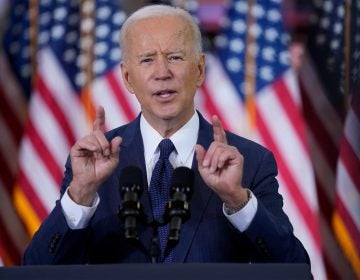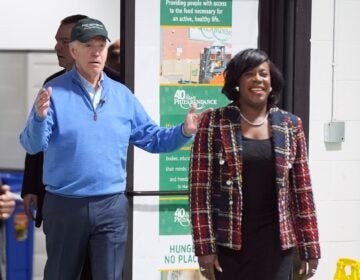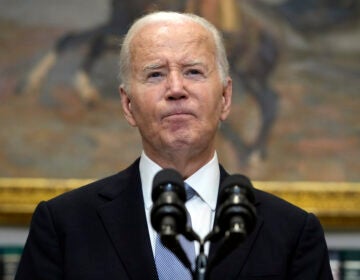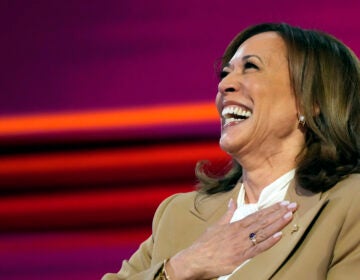Biden celebrates trains in Philly, and Pa. crosses its fingers for infrastructure funds
Biden’s visit to 30th Street Station centered on his proposal to invest heavily in building new infrastructure and developing green technology.
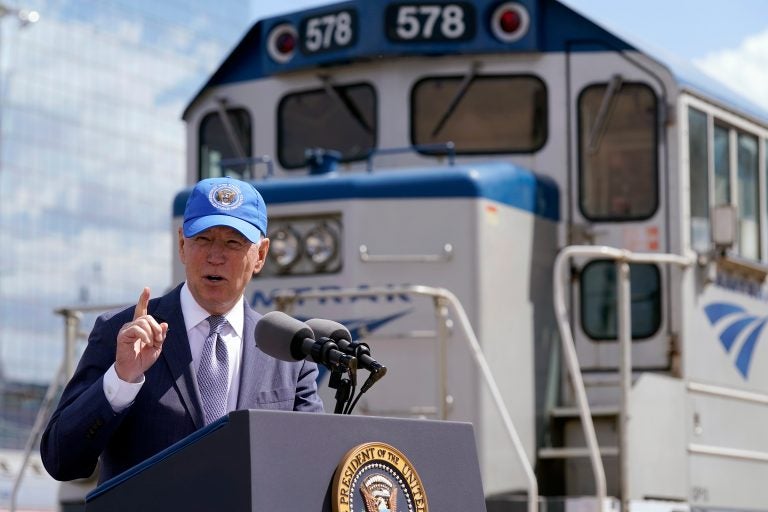
President Joe Biden speaks during an event to mark Amtrak's 50th anniversary at 30th Street Station in Philadelphia, Friday, April 30, 2021. (AP Photo/Patrick Semansky)
Few politicians are more associated with Amtrak than Joe Biden. And for Biden’s speech in Philadelphia Thursday, he made sure people didn’t forget it. He spoke on the tracks in the 30th Street Station rail yard, surrounded by train cars.
Biden hasn’t spent much time at this particular station. He mainly came here by accident, he said, when he fell asleep on the train after late sessions and missed his Delaware stop.
But he has a lot of big infrastructure promises for Pennsylvania — and he said Friday, they’re based on his firm belief that trains are one of the best ways to cut greenhouse gas emissions, while serving as a way to provide some jobs, and facilitate others by offering more convenient paths to cities currently underserved by public transit.
“We have a huge opportunity to provide fast, safe, reliable transportation” in this country,” he said, adding that when it comes to widespread high-speed rail, “we’re way behind the rest of the world right now.”
The visit is part of a countrywide tour marking Biden’s first 100 days in office. At the center of it is his administration’s proposal to invest heavily in fixing and building new infrastructure, developing green technology, and integrating it into American life.
That “American Jobs” plan is accompanied by Biden’s social program-focused American Families Plan, and the two together would cost a little over $4 trillion, on top of the almost $2 trillion coronavirus relief bill that Congress passed, and Biden signed, in March.
Together, the pair calls for an influx of public spending with little precedent in modern history, leading many observers to compare Biden’s proposals to the New Deal.
The infrastructure portion is sweeping. It includes $200 billion for building and improving affordable housing, subsidies to the clean energy and domestic manufacturing industries, and plans to upgrade 20,000 miles of roads and repair 10,000 bridges.
In Philly, Biden focused on the portions that involve rail travel and shipping. There are two major provisions: $85 billion for primarily intra-city services, like commuter rail and buses, and $80 billion for major passenger and freight lines.
“Last week, I announced a target of cutting greenhouse gases and gas emissions in half by 2030,” he said. “Most of those emissions in this country come from transportation. But if just 10% of the freight shipped in the largest trucks went by rail instead, we’d be removing 3,300,000 cars from the road.”
Gov. Tom Wolf, who was in the audience, said that was music to his ears. Wolf lives in York and works in Harrisburg, two cities in an area of Pennsylvania that has seen enormous growth in the trucking industry. But he said Harrisburg’s train station is a good example of the possibilities in Biden’s plan — it can handle intermodal freight, which can be moved from truck to train in the same container.
“If you do that right, you can have trucks doing the short hauls, and the trains do the long hauls, and you can make a big dent in the carbon footprint in the United States, and do a much more efficient job at transporting materials,” Wolf said.
A spokesperson for Pennsylvania’s Department of Transportation also noted, the state’s needs reach well beyond rail.
“Pennsylvania is a large state with a vast, but aging, transportation network,” the department said in an email. “We currently have $9.3 billion in unmet needs across our state-maintained system alone.”
The department is encouraged, it said, by the “breadth and depth” of the jobs plan.
In Philadelphia, where the pandemic has wreaked havoc on the SEPTA’s finances, and the city is relying heavily on federal relief money, transit advocates have a long list of hopes for the infrastructure plan.
A spokesperson for the city said the Office of Transportation, Infrastructure and Sustainability has a long list of projects that it hopes can be helped along by federal dollars. They include modernizing SEPTA trolleys, making Roosevelt Boulevard — known to be the deadliest road in Philly — safer, building new affordable housing and improving existing units, updating school buildings, and increasing capacity at the port of Philadelphia.
The office noted there is an item on its wish list that’s not in Biden’s plan: lead paint removal.
“The City is very supportive of the President’s focus on removing lead pipes for improved drinking water,” a spokesperson said in an email. “Yet for a city like Philadelphia lead paint in homes remains a health risk for our children, so Philadelphia would welcome a broader view of lead removal that also includes additional funding for the removal of lead paint for homeowners and renters.”
Biden’s jobs plan needs the support of Congress. The toughest sell will be in the Senate, where Democrats’ advantage is razor thin. There is bipartisan support for infrastructure investment, but Republicans — and some Democrats — have balked at the president’s spending estimates.
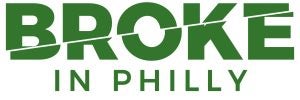 WHYY is one of over 20 news organizations producing Broke in Philly, a collaborative reporting project on solutions to poverty and the city’s push towards economic justice. Follow us at @BrokeInPhilly.
WHYY is one of over 20 news organizations producing Broke in Philly, a collaborative reporting project on solutions to poverty and the city’s push towards economic justice. Follow us at @BrokeInPhilly.

Get daily updates from WHYY News!
WHYY is your source for fact-based, in-depth journalism and information. As a nonprofit organization, we rely on financial support from readers like you. Please give today.



